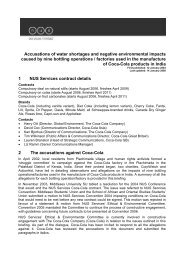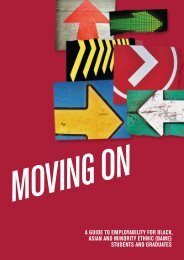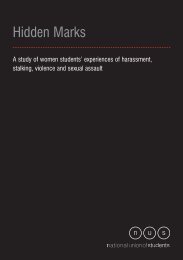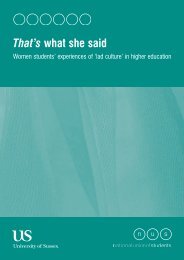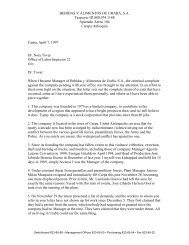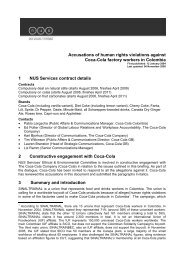No Place for Hate Crime - National Union of Students
No Place for Hate Crime - National Union of Students
No Place for Hate Crime - National Union of Students
You also want an ePaper? Increase the reach of your titles
YUMPU automatically turns print PDFs into web optimized ePapers that Google loves.
<strong>No</strong> <strong>Place</strong> <strong>for</strong> <strong>Hate</strong><br />
Victims<br />
When applicable, respondents were asked in<strong>for</strong>mation<br />
about the number <strong>of</strong> victims involved. More than two<br />
in three incidents took place when the victim was in<br />
the company <strong>of</strong> other people, and in many cases<br />
their companions also became victims. This finding<br />
suggests that incidence rates could very well be higher<br />
than our estimates.<br />
In 29 per cent <strong>of</strong> incidents involving bias against the<br />
student’s sexual orientation, the victim was alone<br />
and the only recipient <strong>of</strong> harassment. 20 In 71 per cent<br />
<strong>of</strong> cases, the victim was in the company <strong>of</strong> others.<br />
In half <strong>of</strong> these cases, respondents indicated their<br />
companions were also victims.<br />
Thirty-one per cent <strong>of</strong> incidents believed to be<br />
prejudiced against the victim’s gender identity occurred<br />
while they were alone. 21 Of those who were with<br />
companions, 38 per cent reported the perpetrator(s)<br />
also targeted their friends.<br />
Perpetrators<br />
Number <strong>of</strong> perpetrators<br />
The evidence suggests that perpetrators <strong>of</strong>ten acted<br />
as a group, particularly in incidents involving face-t<strong>of</strong>ace<br />
contact with the victim(s), such as in verbal and<br />
physical abuse.<br />
Fifty-one per cent <strong>of</strong> incidents involving bias against<br />
the victim’s sexual orientation were reported to have<br />
involved more than one perpetrator, with another 23<br />
per cent indicating they were unsure <strong>of</strong> the number <strong>of</strong><br />
perpetrators. This is particularly disturbing in cases <strong>of</strong><br />
physical assault, where 52 per cent (69 <strong>of</strong> 132) involved<br />
multiple perpetrators: 28 per cent <strong>of</strong> incidents involving<br />
two or three perpetrators, 16 per cent involving four to<br />
six, and 8 per cent involving six or more perpetrators.<br />
Incidents involving a prejudice against the victim’s<br />
gender identity were less likely to involve multiple<br />
perpetrators, though a substantial number (35 per<br />
cent) were apparently committed by more than one<br />
individual.<br />
Relationship to victim<br />
Strangers were found to have committed the majority<br />
<strong>of</strong> incidents reported in our survey (58 per cent <strong>of</strong><br />
those prejudiced against the victim’s sexual orientation<br />
and 70 per cent against their gender identity). The<br />
exception to this was in cases <strong>of</strong> prejudiced written<br />
communication, which, due to the nature <strong>of</strong> this type <strong>of</strong><br />
incident, primarily involved people known to the victim,<br />
such as acquaintances or friends.<br />
That is not to say, however, that the perpetrators were<br />
completely unknown to the victims. The majority<br />
<strong>of</strong> victims were in fact able to state whether the<br />
person(s) in question were students, even when they<br />
had indicated that the perpetrators were strangers.<br />
Perpetrators were more <strong>of</strong>ten than not someone who<br />
was simultaneously a stranger and someone familiar to<br />
the victim, by way <strong>of</strong> a shared context or place.<br />
“The people [perpetrators <strong>of</strong> homophobic<br />
communication] were from my old school, where I<br />
was ‘famous’ <strong>for</strong> my sexual identity.”<br />
“The perpetrators knew people who know that I<br />
am gay.”<br />
In 45 per cent <strong>of</strong> incidents motivated by a prejudice<br />
against the victim’s sexual orientation, the perpetrator<br />
was known to be a student. Of these, 85 per cent<br />
were reported to be students at the victim’s college or<br />
university (or in cases <strong>of</strong> multiple perpetrators, involved<br />
at least one student at the victim’s institution).<br />
The same percentage <strong>of</strong> incidents motivated by a bias<br />
against the victim’s gender identity (45 per cent) were<br />
committed by students, the large majority <strong>of</strong> whom also<br />
studied at their college or university (84 per cent).<br />
This finding is significant, not only because some<br />
students are committing such acts, but also because<br />
the nature <strong>of</strong> close, inter-group relations within many<br />
institutions means that victims <strong>of</strong>ten find it difficult to<br />
avoid interacting with their abusers in the aftermath <strong>of</strong><br />
incidents. This has clear implications on the victims’<br />
inclination to report the incident, as well as the overall<br />
impact <strong>of</strong> the experience on their studies and mental<br />
well-being, as discussed in Chapter 6.<br />
36



